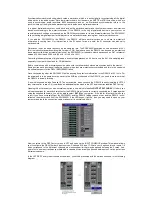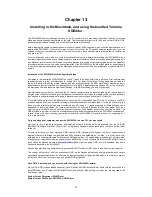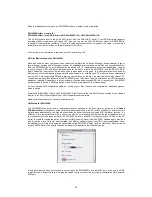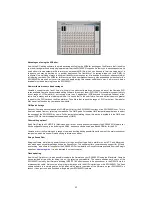
50
Chapter 11
The DS2416 linkup
The SW1000XG is also known as the Audio & MIDI Factory card, which forms part of Yamaha’s DSP Factory
solution. Well what is DSP Factory?
DSP factory is Yamaha’s total solution for mixing and producing audio, and at its heart is the DS2416 card. This is a
dedicated DSP based mixing console on a PCI card that is functionally every bit as good as our flagship top of the
range digital mixing consoles such as the 02R and 03D.
A brief overview of the DS2416 card.
The DS2416 is a PCI card with five DSP chips on-board. It provides recording of up to 8 tracks simultaneously and
playback of 16 individual wave streams simultaneously, in addition to mixing quality equal to the Yamaha 02R digital
mixer, and effects processing comparable to the Yamaha ProR3 and REV500.
Like the SW1000XG the DS2416 provides professional quality digital mixing and effects processing without relying
on the computer's CPU. This ensures guaranteed processing power regardless of other tasks the CPU may be
performing. Mixing and effects parameters can be adjusted in real-time, as opposed to the sluggish performance
common in CPU-based mixers. And by significantly reducing the load on the computers CPU, much more accurate
record and playback timing can be achieved.
So what are the differences?
Well if we look at the DS2416 as a professional digital mixing desk on a card, and the SW1000XG as a synth,
expandable plug in system host, mixer, effects processor and MIDI interface all in one it pretty well sums up the 2
cards differences.
Whilst the DS2416 has 5 DSP processors dedicated to mixing, effects processing (2 effects busses), dynamics
processing (compressors, expanders, duckers on every channel), equalisation (104 bands of eq are permanently
accessible as 4 band parametric eq on every audio part), and routing. The DSP processors on the SW1000XG as we
have seen are dedicated to the effects processing (6 busses), mixing, synth engine, routing, and master EQ.
If you plan to work totally with audio, then the concept of the DS2416 may be more appealing to you, as the option of
owning what is, a multi thousand dollar Yamaha digital mixer on a card for a relatively low cost is exciting.
So why do the 2 cards exist?
Well, as we have said, the DS2416 is designed purely for mixing audio, whilst the SW1000XG is a professional synth
and mixer and effects unit all in one. The SW1000XG doesn’t have all of the mixing capabilities of the DS2416 (eq as
we mentioned in the previous chapter is not available on every audio part at the same time), but has a powerful synth
engine on board.
This also applies to dynamics processors. The DS2416 has 26 of these, which are always available and can be
applied to any audio track at will. It does however only have 2 effects busses as opposed to the 6 of the SW1000XG,
and don’t forget that the DS2416 has no MIDI functionality at all, and no synthesiser or expansion for PLG cards.
The beauty of the Yamaha '‘Factory” concept is that the 2 cards talk to each other and really are designed to work
alongside each other seamlessly in any computer environment, the question is ‘How do I make this happen?” This
chapter aims to show you!
As we covered in our opening chapters, the SW1000XG has 2 connectors along its top edge. The PLG connector we
have covered in detail, now it is the turn of the CN102 connector, which is the larger black connector on the top edge.
What does this do.
The SW1000XG comes supplied with a short ribbon cable that has a black moulded lump in the middle of it. This is a
ferrite core, designed to stop the incredibly noisy computer environment from affecting or disrupting signals flowing
between the 2 cards. Along the top edge of the DS2416, you will also find a set of similar connectors, one of which is
designed to be attached to the cable that comes with your SW1000XG. The correct connector is shown in the
diagram below
















































